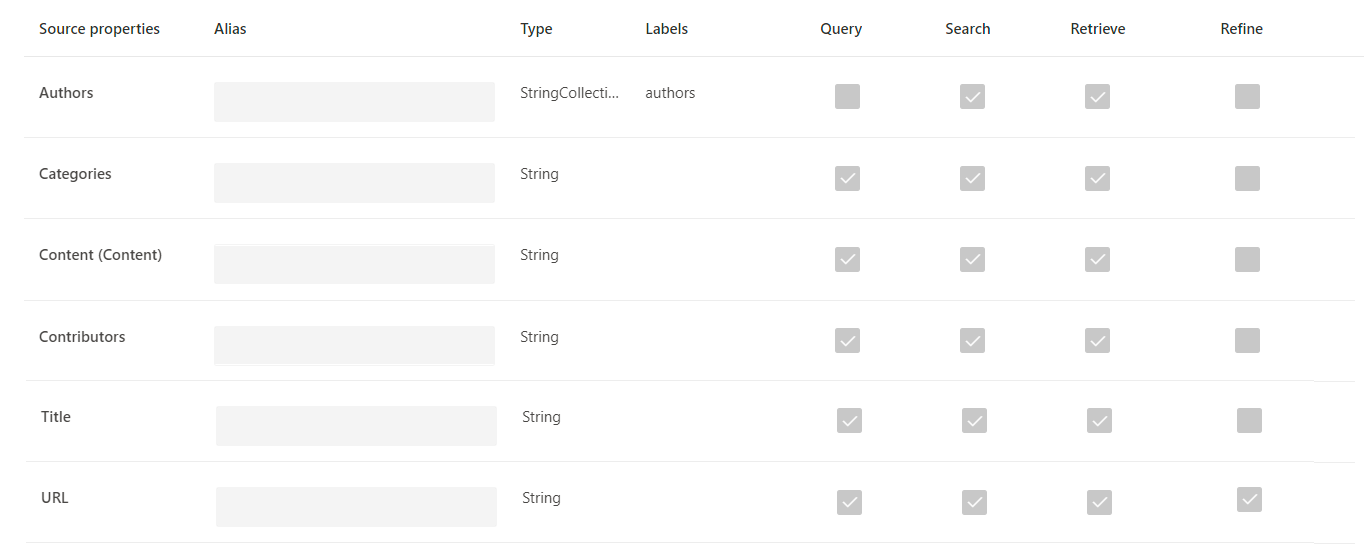Note
Access to this page requires authorization. You can try signing in or changing directories.
Access to this page requires authorization. You can try changing directories.
This article describes the steps to set up a Microsoft 365 Copilot connector in the Microsoft 365 admin center. The setup process is streamlined, with minimal inputs that simplify connection creation. You can also customize the setup to fine-tune specific settings.
Note
The setup process is similar for all Microsoft-built Copilot connectors, but it isn't the same for all. Be sure to read the connector-specific information for your data source.
Tip
Product survey
To help us understand your requirements related to connecting more data sources to Copilot or Microsoft Search, please fill out this survey form. We'll use the survey results to prioritize new data sources for connectors.
Prerequisites
Before you begin, make sure that you have the following:
- Admin access: You must have either of the following roles in the Microsoft 365 admin center to configure a Copilot connector - Global admin, Search admin, or Copilot admin.
- Data source credentials: Collect the necessary credentials and permissions for the data source you want to connect.
- Service account (if applicable): If your data source requires a service account, ensure it has the necessary roles or permissions.
Step 1: Add a Copilot connector
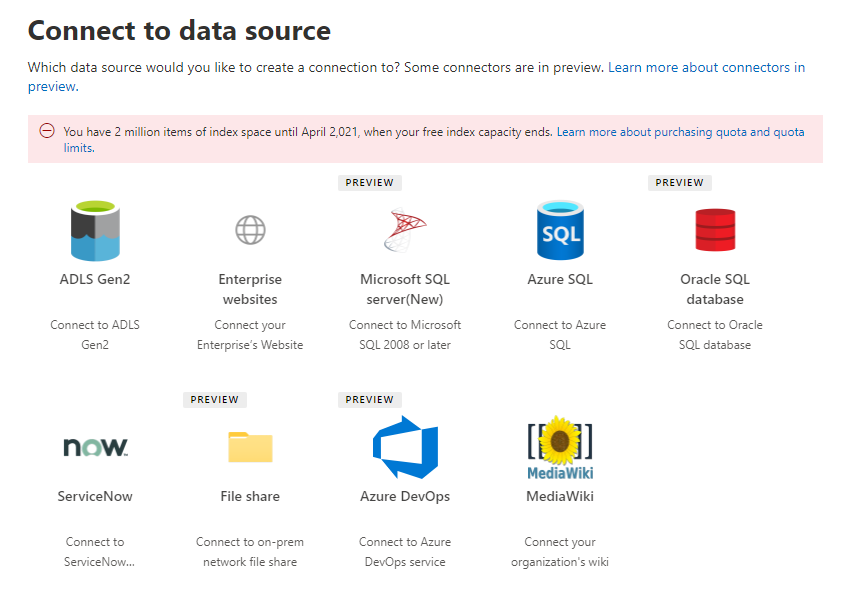
Complete the following steps to configure any of the Copilot connectors (or go to the admin center to access the connector catalog):
Open the Microsoft 365 Admin Center:
- Sign in to the Microsoft 365 admin center.
Go to settings:
- In the left navigation pane, select Copilot.
- Choose Connectors.
Add a new data source:
- Go to the Connectors tab.
- In the left navigation pane, choose Gallery.
- From the list of available connectors, select the data source you want to connect (for example, ServiceNow Knowledge, or Salesforce).
Step 2: Enter basic connection details

Display name:
- To help users recognize the source in Copilot and search results, enter a name to identify the connector.
- A default name is provided, but you can customize it to suit your organization's needs.
ServiceNow instance URL:
- Provide the URL of your data source. For example, if you’re connecting to ServiceNow, the URL might look like
https://your-organization-name.service-now.com.
- Provide the URL of your data source. For example, if you’re connecting to ServiceNow, the URL might look like
Authentication type:
- Choose an authentication method to access the data source.
Staged rollout to limited audience
- Initially, you can deploy the connector to a subset of users for validation in Copilot and other search surfaces. This feature allows you to test the integration before broader rollout.
Note
For most connectors, default settings are optimized for the data source. These settings include access permissions, schema, and sync frequency. If you want to edit any of these settings, you need to choose the "Custom Setup" option.
Step 3: Create the connection
- Select Create to set up the connection. The connector begins indexing content from your data source using default settings.
Once the connection is created, you can add a description for the connection in the success screen. To help Copilot enhance connection results for users, the description should answer the following questions briefly:
- What kind of content does this connection have?
- How do users refer to this content source in their respective orgs?
- What part of the workflow do users refer to this content in their day-to-day work?
- What are some characteristics of the content?
To learn more, refer to the Enhancing Microsoft Copilot discovery with Copilot connector Content article.
Step 4: Customize connector configuration (optional)
Admins who want more control over the configuration can choose the Custom setup option. This option provides access to three tabs for detailed settings: Users, Content, and Sync.
Users
Access Permissions:
- Choose whether indexed data is visible to:
- Everyone in the organization.
- Only people with access to the content in the data source.
- Choose whether indexed data is visible to:
Map Identities:
- By default, users are mapped by checking whether their email in the data source matches a
UserPrincipalNameorMailin Microsoft Entra ID. - If this default doesn’t work for your organization, provide a custom mapping formula.
- By default, users are mapped by checking whether their email in the data source matches a
Content
Manage properties:
- Configure properties from the data source, such as making them searchable, queryable, or refinable.
- Assign semantic labels and aliases to enhance search relevance.
- Customize the value of properties like URL for certain connectors. More details here.
For more information on Manage Properties, see below.
Sync
Refresh intervals:
Configure the frequency of data syncs between the data source and the Copilot connector index.
- Full crawl: Synchronizes all data at scheduled intervals.
- Incremental crawl: Updates only the changed or new data.
Adjust the default sync settings as required for your organization.
For more information on Sync settings, see below.
Guidelines for Manage Properties settings
Content property
We recommend that you select a Content property from the drop-down menu of options, or keep the default if one is present. This property is used for full-text indexing of content, search results page snippet generation, result cluster participation, language detection, HTML/text support, ranking and relevance, and query formulation.
If you select a content property, you have the option of using the system-generated property ResultSnippet when you create your result type. This property serves as a placeholder for the dynamic snippets that are generated from the content property at query time. If you use this property in your result type, snippets are generated in your search results.
Aliases for source properties
You can add aliases to your properties under the "Alias" column. Aliases are friendly names for your properties. They're used in queries and in the creation of filters. They're also used to normalize source properties from multiple connections such that they have the same name. That way you can create a single filter for a vertical with multiple connections. For more information, see Customize the search results page.
Semantic labels for source properties
You can assign semantic labels to your source properties. Labels are well-known tags provided by Microsoft that provide semantic meaning. They allow Microsoft to integrate your connector data into Microsoft 365 experiences such as Copilot, enhanced search, people cards, intelligent discovery, and more.
The following table lists the currently supported labels and their descriptions.
| Label | Description |
|---|---|
| title | The title for the item that you want to be shown in search and other experiences |
| url | The target URL of the item in the source system |
| Created By | Name of the person who created the item |
| Last modified by | Name of the person who most recently edited the item |
| Authors | Name of the people who participated/collaborated on the item |
| Created date time | Time when the item was created |
| Last modified date time | Time when the item was most recently edited |
| File name | Name of the file item |
| File extension | Type of file item, such as PDF or DOC |
The properties on this page are pre-selected based on your data source, but you can change this selection if there's a different property that is better suited for a particular label.
The label title is the most important label. We strongly recommend that you have a property assigned to this label for your connection to participate in the result cluster experience.
Incorrectly mapping labels causes a deteriorated search experience. It's okay for some labels not to have a property assigned to them.
Search schema attributes
Note
The "int" datatype properties cannot be refined, even if marked as refinable.
You can set the search schema attributes to control the search functionality of each source property. A search schema helps determine what results are displayed on the search results page and what information end users can view and access.
Search schema attributes include options to Query, Search, Retrieve, and Refine. The following table lists each of the attributes that Copilot connectors support and explains their functions.
| Search schema attribute | Function | Example |
|---|---|---|
| SEARCH | Makes the text content of a property searchable. Property contents are included in the full-text index. | If the property is title, a query for Enterprise returns answers that contain the word Enterprise in any text or title. |
| QUERY | Searches by query for a match for a particular property. The property name can then be specified in the query either programmatically or verbatim. | If the Title property can be queried, then the query Title: Enterprise is supported. |
| RETRIEVE | Only retrievable properties can be used in the result type and displayed in the search result. | |
| REFINE | The refine option can be used on the Microsoft Search results page. | Users in your organization can filter by URL on the search results page if the refine property is marked during connection setup. |
For all connectors except the File share Copilot connector, custom types must be set manually. To activate search capabilities for each field, you need a search schema mapped to a list of properties. The connection configuration assistant automatically selects a search schema based on the set of source properties you choose. You can modify this schema by selecting the check boxes for each property and attribute on the search schema page.
Restrictions and recommendations for search schema settings
The content property is searchable only. After you select it in the dropdown, this property can't be used with the options retrieve or query.
Significant performance issues occur when search results render with the content property. An example is the Text content field for a ServiceNow knowledge-base article.
Only properties marked as retrievable render in the search results and can be used to create modern result types (MRTs).
Only string properties can be marked searchable.
Note
To update the schema after creating a connection, refer manage search schema article.
Customize values for certain Schema Properties
For certain connectors like ServiceNow, specific properties like AccessURL can be customized as per the organization's needs. For example, if the URL of the ServiceNow Knowledge articles in your organization is different from the ServiceNow URL which opens up through the citation links present in responses to your queries in Microsoft Search or Copilot, then you can use this customization capability to configure the value of the AccessURL property in your desired manner.
Note
Currently to use this capability of customizing the schema property, you need to create a new connection for your copilot connector. We don't currently support editing an existing connection to make this change in the schema property.
Below are the steps to customize the value of any schema property:
- During connection setup before you publish your connection, select “Custom Setup” shown at the top of the window & then successfully “Authenticate” your credentials first.
- Next before publishing, select “Content” tab & go down to the “Manage Properties” section
- In the table shown under the “Properties” Column, select the desired property (For e.g. URL property) which you want to customize
- In the right-side panel that opens, look for “Default expression” section
- Under this section, enter the default expression that you want to set for the property in the “New default Expression” text field box.
- For any variable components within the expression, reference them by their precise Property Name enclosed within the symbols ${ and }
- Please do remember to Select “Save Changes” at the bottom of the side panel once all the details are provided for the changes to be saved & become effective for preview.
- Once the expression is defined, you can preview the results by selecting “Preview Data” shown at top the Content tab & scrolling right to the Property you had customized to ensure the expression is correctly captured as set by you.
For example:
Let's say in the ServiceNow instance for your organization, the URL for any dummy article is shown as
https://instancedomain.service-now.com/sp?id=kb_article&sys_id=1A2bcd3e45f6ghij17890kl1mn2345678o
So, we need to use the entire URL as it is & just replace the article specific variable component i.e., it's sys_id in the above case with the Exact Property Name used to index the sys_id in the connector properties. Look for the table under Manage Properties under Content Tab & search for the property you are looking for (lets assume, its SysId in this case). So, here we need to provide the expression as
https://instancedomain.service-now.com/sp?id=kb_article&sys_id=${SysId}
Sharing some more examples in the table below:
| Connector | URL in your organization | What to set as default expression |
|---|---|---|
| ServiceNow Knowledge | https://contosos.service-now.com/serviceportal?id=kb_article_view&sysparm_article=KB0102362 |
https://contosos.service-now.com/serviceportal?id=kb_article_view&sysparm_article=${Number} |
| ServiceNow Knowledge | https://custom.contoso.com/knowp?id=kb_article&table=kb_knowledge&sys_id=a3f66636838e9a90 |
https://custom.contoso.com/knowp?id=kb_article&table=kb_knowledge&sys_id=${SysId} |
| ServiceNow Catalog | https://custom.contoso.com/sp?id=sc_cat_item&sys_id=bf21d3a54731465c34 |
https://custom.contoso.com/sp?id=sc_cat_item&sys_id=${SysId} |
| ServiceNow Catalog | https://contoso.service-now.com/1M_PorTAL?id=sc_cat_item&table=sc_cat_item&sys_id=4df777541b37ab4000 |
https://contoso.service-now.com/1M_PorTAL?id=sc_cat_item&table=sc_cat_item&sys_id=${SysId} |
| ServiceNow Ticket | https://contoso.service-now.com/esc?id=ticket&table=sc_req_item&sys_id=113851de1b7894&view=sp |
https://contoso.service-now.com/esc?id=ticket&table=${EntityType}&sys_id=${SysId}&view=sp |
| ServiceNow Ticket | https://contoso.service-now.com/esc?id=ticket&sys_id=a3f66636838e9a9a&table=incident |
https://contoso.service-now.com/esc?id=ticket&sys_id=${SysId}&table=${EntityType} |
Add rules to customization for Schema properties
For certain connectors, you can additionally bypass the default expression for select items by adding rules for defining different default expressions based on certain conditions for the property filters like
- Knowledge Base for ServiceNow Knowledge
- Catalog Category for ServiceNow Catalog.
- Entity Type (tables like incident, change_request) for ServiceNow Tickets
Below are the steps to set the rules for defining additional default expression for specific items:
- Repeat steps 1 to 4 as mentioned above.
- Under the section “Set additional rules to configure expressions”, select “Add new rules”
- Upon selecting “Add new rule”, a new section opens in the side panel wherein you can
- Select the “Filter Property” i.e. “KbKnowledgeBase” for ServiceNow Knowledge or “Category” for ServiceNow Catalog
- Provide the “Value” for the Filter property using the exact case format as it is in your connection's schema properties. If you want to set the same expression for multiple values of the property, then provide the names of all values separated by comma.
- Define the “Expression” that you want to set for items belonging to those filter properties.
- Once you have entered all the details, select “Save changes” to save your changes & set the rule for the expression
- You will return to the previous side panel & see that the new rule is added in a table shown under the sub section “Set additional rules to configure expressions”
- Do remember to again select “Save changes” at the bottom of the side panel once all the details are provided for the changes to be saved & become effective for preview.
- If there are more rules to be added, you can further select “Add new rule” & follow the above steps to set the new rule.
- You can also edit/delete an existing rule by selectinging on the 3 dots (...) that appear on the right-hand side of each row for the rules & then selecting either the “Edit” or “Delete” action.
- Once the expression is defined, you can preview the results by selecting “Preview Data” shown at top the Content tab & scrolling right to the desired Property to validate the customized expression.
Note
- If an item is part of multiple rules defined here, then the rule which was defined first in the order of rules will be applied, i.e. from the table, the rule which appears first in the table will get applied.
- The changes to the URL property i.e. setting of default expressions, addition of rules or any edit/delete of rule will start reflecting in the copilot results only after the next scheduled periodic full crawl.
For example:
In ServiceNow knowledge, if the default URL expression needs to be set differently for articles belonging to "IT" & "HR Policy" knowledge base, then set rule by choosing Filter as "KbKnowledgeBase", defining its value separated by comma as "IT, HR policy", & then defining the expression as per the articles from these knowledge bases, let’s say like this-
https://instancedomain.service-now.com/esc?id=kb_article_view&sysparm_article=${Number}
Guidelines for Sync settings
The refresh interval determines how often your data is synced between the data source and Microsoft Search. Each type of data source has a different set of optimal refresh schedules based on how often data is modified and the type of modifications.
There are two types of refresh intervals, Full refresh and Incremental refresh, but incremental refreshes aren't available for some data sources.
With a full refresh, the search engine processes and indexes the items that have changed in the content source, regardless of previous crawls. A full refresh works best for these situations:
- Detecting deletions of data.
- The incremental refresh found errors, and failed.
- ACLs (Access Control Lists) were modified.
- Crawl rules were modified.
- The schema for the connection was updated.
With an Incremental refresh, the search engine can process and index only the items that were created or modified since the last successful crawl. As a result, not all the data in the content source is reindexed. Incremental refreshes work best to detect content, metadata, and other updates.
Note
Incremental crawls don't currently support processing of updates to permissions.
Incremental refreshes are faster than full refreshes because unchanged items aren't processed. However, if you choose to run incremental refreshes, you still need to run full refreshes periodically to maintain correct data sync between the content source and the search index.
Crawl Scheduling
You can configure full and incremental crawls based on the advanced scheduling options present on the Refresh Settings page. Some connectors don't support incremental crawls and the option to configure incremental crawls aren't available for those connectors. For others, the incremental crawl is an optional crawl and is enabled by default. A crawl schedule is selected by default for you based on the connector type. This default setting can be changed during connection creation or edited after a connection is published from the "Edit" flow of a connection. You can choose from these fields:
- Recurrence: You can choose to run the crawls every day, week, 2nd week, or 4th week.
- Day(s): This option is enabled when you choose to run crawls only on specific days of the week.
- Run once a day check box lets you choose the start time of the crawl in a day. If not selected, the crawls repeat in a day by default. You can choose the repeat interval from the dropdown.
- Frequency: Select this option if you want to repeat crawls in a day after certain time intervals. The smallest repeat frequency is 15 minutes, and the largest is 12 hours.
- Starting Time: Select the time when you want the crawl to start.
- Reset: This option resets the schedule to the connector's default schedule.
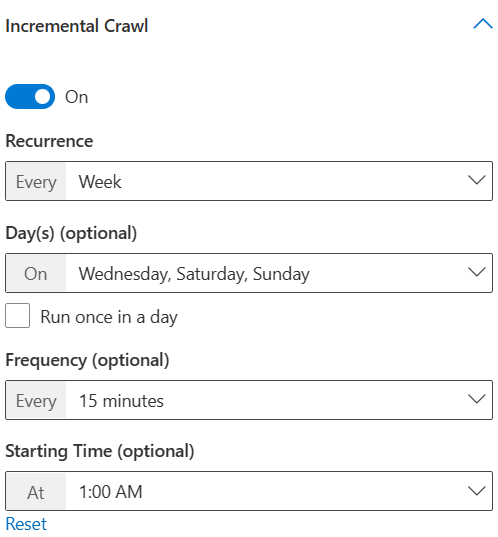
Here are certain points to note while configuring the crawl schedule:
- If you leave any of the fields empty, or unselected, Copilot connectors pick the best time to start a crawl. For example if you choose a crawl Recurrence as "Day" and don't select the start time, Copilot connectors choose the time based on your last crawl to start the new crawl. If you don't want to specify a start time of the crawl, it's a good practice to let the connector decide when to start the crawl.
- Even if the start time is mentioned, the crawl start may delay by an hour. This delay can be because of reasons such as network load etc.
- If the previous crawl overruns to the time of the next crawl, we don't stop the ongoing crawl and queue the next crawl. After the ongoing crawl is complete, we run the queued crawl only if it is of a different type (full/incremental) than the previous crawl. For example, if an incremental crawl overruns the next full crawl, we don't suspend the incremental crawl and queue the full crawl. After the completion of the incremental crawl, since the queued crawl is of different type (full), we start the full crawl immediately.
These are some of the scenarios:
- Run incremental crawl daily after every 15 minutes
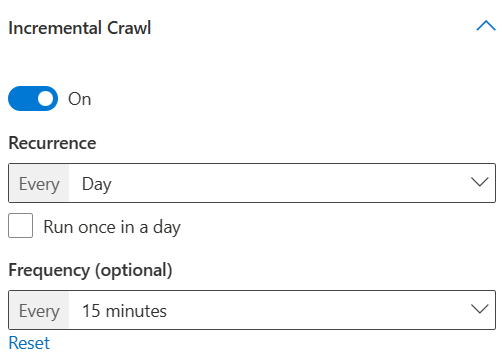
Here selecting the "Run once in a day" checkbox lets you choose the "Start time" to run incremental crawl only once in a day starting at the specified time. However, unselecting it lets you choose the frequency of crawl repetitions in a day. If you want your data to be continuously refreshed, you can choose to run incremental crawls frequently in a day. But if the number of items in data source is large and the crawls tend to be longer, or if frequent updates aren't needed for the content, you can choose the incremental crawl to run once in a day.
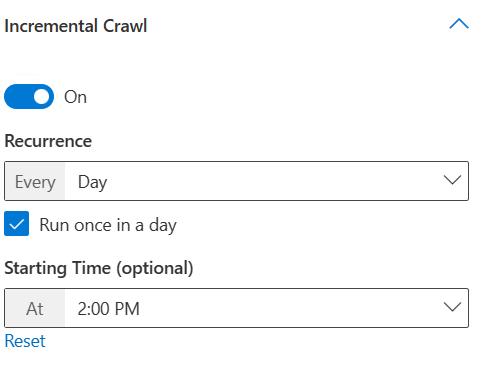
- Run incremental crawl every week on Wednesday, Saturday, and Sunday repeating every 15 minutes and starting at 1:00 AM

- Run full crawl every day at 1:00 AM
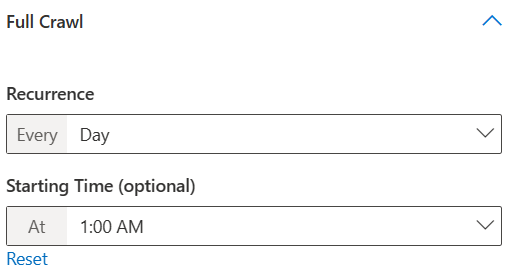
- Run full crawl every week on Friday at 8:00 PM
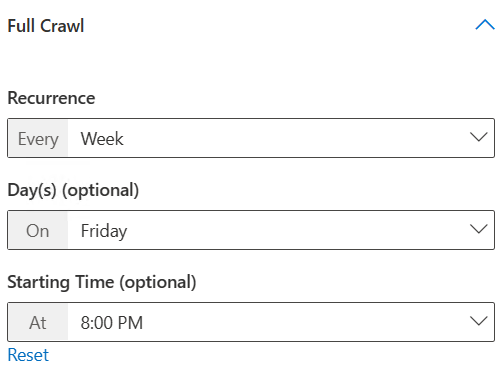
IP Firewall rules
IP firewall rules are configured to secure access to your data source by allowing only specific IP addresses. In such a scenario, permit access to the Copilot connectors service IP ranges to allow access to your data source. Specify the following IP ranges in the firewall settings of your SaaS platform.
| Region | Microsoft 365 Enterprise | Microsoft 365 Government |
|---|---|---|
| NAM | 52.250.92.252/30, 52.224.250.216/30 | 52.245.230.216/30, 20.141.117.64/30 |
| EUR | 20.54.41.208/30, 51.105.159.88/30 | NA |
| APC | 52.139.188.212/30, 20.43.146.44/30 | NA |



